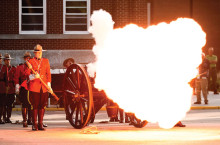
Behind the Red Serge
“Most people who visit the Heritage Centre are surprised to learn that the RCMP’s international role started with Sitting Bull,” explained Robin Etherington, President and CEO of the Heritage Centre.
In 1876, Sitting Bull fled from the United States and crossed the 49th parallel into Canada to seek refuge after his resounding defeat of General Custer and the 7th Cavalry at the Little Big Horn. North West Mounted Police (NWMP) Inspector, James Walsh, courageously rode into Sitting Bull’s camp of 5,000 Sioux to tell him that he must obey Canada’s law. It’s just one of the many fascinating things that visitors discover at the RCMP Heritage Centre in Regina. (The NWMP was the precursor to the RCMP).
On August 30, 1873, an Act of Parliament authorized the establishment of the NWMP. Prime Minister John A. Macdonald’s decision to create a national police force was propelled to a great extent by the Cypress Hills Massacre of Assiniboine Indians in May 1873. The NWMP’s first role was to bring law and order to the West, drive out the whisky traders and outlaws, form friendly relations with indigenous peoples, and ensure the safety of rail workers and new settlers.

The Heritage Centre captures this colourful Western history including the incredible “Great March West,” led by Colonel French, when 310 horses and a force of 300 men left Fort Dufferin in Manitoba to establish the first forts in the West?—?Fort Macleod in 1874 and Fort Walsh in 1875.
In an exhibit on the March West visitors sit in a tent, just like the one used back then, and listen to the words of Cecil Denny who had joined the march as a journalist. As he describes a terrible thunderstorm on the prairies, suddenly, the whole tent shakes, creating the feeling that you are in the midst of it. Denny’s book, The Law Marches West, also describes other hardships?—?the clouds of mosquitoes, how the recruits were half starved on government rations and how the 4,400 pound artillery had to be dragged across the prairie.
The RCMP’s international role has evolved considerably since its dramatic beginnings in Western Canada, a role demonstrated in the exhibit, Serving All of Canada. Today, RCMP officers gather intelligence to fight terrorism, train police forces in foreign countries and participate in humanitarian activities in countries such as Haiti and Africa. The RCMP’s activities both at home and abroad have resulted in world-wide recognition as a top police force.
Another exhibit captures the force’s colourful role during the Klondike Gold Rush in the Yukon, when it manned the Chilkoot and Mountain passes from 1897 to 1900 and put an end to the Mad Trapper’s illegal activities at Rat River. The RCMP’s role continues in the northern parts of Canada and includes a lot of work with First Nations and Inuit.
“Visitors like all of our exhibits, but the most popular is the forensics one?—?people three to ninety love it,” says Etherington. It’s easy to understand why. As visitors enter the interactive, Cracking the Case exhibit, it shows a murder scene and offers clues on how to solve it.
Authentic, amazing artifacts accompany all exhibits. Rhonda Lamb, Manager of the RCMP Historical Collections Unit, says, “The collection of museum artifacts started in 1933. Today, it has a very eclectic collection where five percent of a total of about 35,000 artefacts are on display at any one time.”
Established in 1885, the adjacent RCMP ‘Depot’ Division is where all future Mounties go for training. Visitors can take a guided tour and observe a “drill” exercise where new recruits must follow exact orders while in line-up formation. If not precisely followed?—?push-ups are quickly assigned.
From the grueling March West of 1874 to its multiple policing activities of today, a visit to the RCMP Heritage Centre vibrantly captures its many roles, past and present.
Part of the interpretive tour includes this standard tourism creative depicting drill class movements which can be observed every Monday, Wednesday and Friday at 12:45 pm at the Sergeant Major’s Parade; a live event held at RCMP Academy “Depot” Division.
The Heritage Centre, which opened in May 2007, is owned and operated by the Mounted Police Heritage Centre Inc., and welcomes about 60,000 visitors per year. It houses a state-of-the-art theatre which features the multimedia presentation, Tour of Duty. A gift shop sells licensed RCMP products, and Saskatchewan and Aboriginal crafts.
RCMP Heritage Centre
5907 Dewdney Ave., Regina, Sask S4T 0P4
306-522-7333

